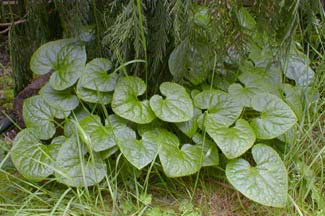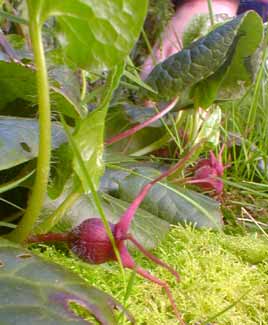 Our Native Wild Ginger:
Our Native Wild Ginger:
Asarum caudatum
We have four species of Asarums in our gardens: a Chinese Giant Asarum; the east coast's Asarum canadense common from New England & Canada; the cultivar Calloway's Asarum, & the subject of the present page, our own Pacific Northwest native ginger, A. caudatum.
Oldest in our garden is A. caudatum. I planted several of these in 2000 & though they were very slow to start spreading, after three year's they've gotten to look quite fluffy, & are especially green & exciting by mid-May when these plants form fresh new leaves suddenly & dramatically.
 This asarum is encountered in the wild growing in quite acid soils covered with conifer needles, so I tried somewhat to duplicate its normal habitat, placing it where acidic needles fall. The one pictured at the top of the page is shown in May (2003) showing perfectly what a beautiful groundcover it is capable of becoming with time. It is on the south side of the Alaska Weeping Cedar, a limb of which has grown right down to the ground, brushing the Asarum, which it doesn't seem to mind. On the north side of the same cedar is a further stretch of A. caudatum, the two twp areas separated by a smaller aea of the Calloway Asarum.
This asarum is encountered in the wild growing in quite acid soils covered with conifer needles, so I tried somewhat to duplicate its normal habitat, placing it where acidic needles fall. The one pictured at the top of the page is shown in May (2003) showing perfectly what a beautiful groundcover it is capable of becoming with time. It is on the south side of the Alaska Weeping Cedar, a limb of which has grown right down to the ground, brushing the Asarum, which it doesn't seem to mind. On the north side of the same cedar is a further stretch of A. caudatum, the two twp areas separated by a smaller aea of the Calloway Asarum. The second photo from March (2004) shows the strange flowers laying on the ground peeping from the edge of the clump, striving to attact beetles or ants to climb into the "urns" with the ultimate intent of having insects disperse its seeds.
Usually these blossoms are this visible only early in the year. By May new leaf growth will completely hide later flowers as well as the drying or decaying first flowers which linger a long time as brown husks. These plants can be very "interactive" in that to appreciate all their traits does require moving the leaves to inspect the green buds & the purple flowers when they are completely hidden, or laying on the ground to see under the edges of leaves as I did to take the second photo.
When I first planted the Northwest Native Ginger, I was reclaiming a part of the yard that had never been planted before & was rather dry, putting in trees & shrubs & groundcovers & watering it regularly. There was absolutely no snail problem at first because snails are rather territorial (if you mark one with paint, & move it to the far side of the yard from its usual haunt, it will not take but a night or two for it to return to the very rock it had grown used to hiding under by day). But I mistakenly thought snails must not like wild ginger since it was never getting nibbled that first year. A year later, snails expanded their territory into the newly moist area, & was I ever disabused of the sentiment that snails don't like gingers!
I try never to use any pesticides, herbicides, fungicides, or anything unnatural in my yard, & am 95% organic, striving for 100%, though in my mind even using "natural" soap to do in aphids is not entirely organic, yet I give myself some forgiveness in these matters. So it sure is tempting to poison those buggering snails when you see what they can do to a hosta or a young patch of asarum.
One year I sent away for snail-eating snails. The majority of these die off in the winter in this area, so it's not like introducing a permanent new species. They eat only the smallest snails & slugs, & the eggs, which does seem to be sufficient to help limit the snail & slug population. Plucking & crushing adult snails at night certainly helps. But I don't go after them aggressively. Instead, I try to select plants that can stand a little nibbling here & there, but with the exceptions, including gingers, hostas, or little starts of just about anything, it's hard to take a "well, snails gotta eat too" attitude all the time.
Asarum canadense